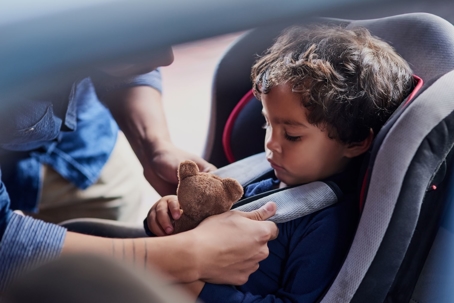Getting into an auto accident is scary for anyone, no matter their age. But having a child sustain injuries in a car accident is every parent’s nightmare and can be a traumatizing, life-altering experience for the child involved.
According to crash data from the National Highway Traffic Safety Administration (NHTSA), injuries sustained in motor vehicle accidents are the leading cause of preventable death among children in the U.S. In 2018 alone, 636 children 12 years old or younger died in car accidents.
If your child has been injured in any type of motor vehicle accident, the first thing you’ll want to do is seek medical treatment for them immediately. Doing so can improve the long-term recovery of their injuries as well as create solid evidence to show the sequence of events that led to your child’s injuries. The doctor should run a series of tests including X-rays, CT scans, and blood tests to show the full extent of your child’s injuries, which may include:
Head Injuries
Concussions, traumatic brain injury (TBI), and other forms of head injuries are a common type of injury sustained for all age groups. However, given that children’s brains are still developing, head injuries sustained by this age group can lead to long-term ramifications, including disabilities, developmental delays, or behavior changes.
Airbag Injuries
While airbags are meant to save lives and reduce the risk of serious injury, they can also be the source of additional injuries to smaller passengers. Young children who sit in the front seat are more likely to sustain facial and neck injuries from airbags, which deploy at around 150-200 mph, than children who sit in the back seat.
Glass Injuries
Windshields, mirrors, or windows that are broken during car accidents can send glass flying and cause cuts (lacerations) on a child’s face or other parts of the body, which can lead to blood loss and potential scarring.
Fractures
Children may sustain fractures to nearly any part of the body in auto accidents; common fractured areas include the arms, wrists, hands, legs, and feet. Additionally, young children may also suffer from broken ribs or pelvic bones due to tightening seat belts or hitting the seats in front of them.
Improving Your Child’s Safety
When it comes to the safety of children within motor vehicles, parents and caregivers have the ability to make a lifesaving difference. While we recognize that accidents caused by other drivers may be unavoidable, the safety of your children remains the top priority.
As such, we urge everyone to understand the importance of seatbelts as well as age- and size-appropriate child car seats. Here are just a few statistics from the Centers for Disease Control and Prevention (CDC) on child passenger safety:
- When used correctly, child car seats reduce the risk of injury in a crash by 71-82%, compared to seat belt use alone
- Booster seats reduce the risk of serious injury to children aged 4-8 by 45%, compared to seat belt use alone
- For older children and adults, seat belts reduce the risk of serious injury and death by about 50%
- In 2018, 33% of children 12 years old or younger who died in motor vehicle accidents were not buckled up at the time of the crash
Advocating on Behalf of You and Your Family
Whether your teenager or tiny child passenger has been injured in a car accident, your child and entire family deserve justice for the harrowing ordeal you have been through. You are not alone through this experience when you come to Effres & Effres for legal guidance.
Our lead attorneys, father-son duo Steve and Justin Effres, understand the importance of family and ensuring that your story is listened to and your voice is heard. You have our word that we will do what it takes to help your family obtain rightful compensation in order to make up for your child’s present and future medical bills, pain and suffering, and other damages.
Contact our Los Angeles injury attorneys at (818) 222-9720 to get started with a free, no-obligation consultation today.

